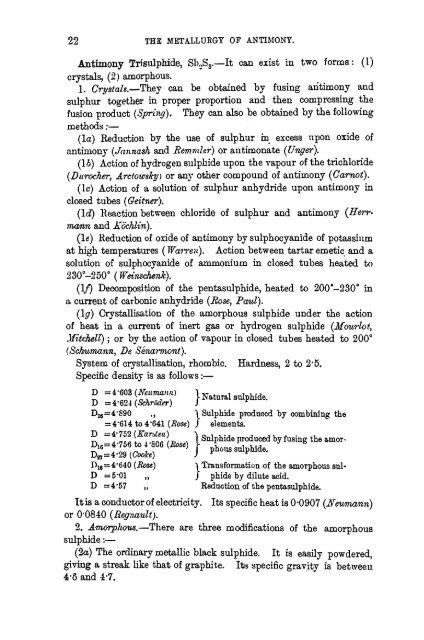antimony - Sciencemadness.org
antimony - Sciencemadness.org
antimony - Sciencemadness.org
Create successful ePaper yourself
Turn your PDF publications into a flip-book with our unique Google optimized e-Paper software.
22 THE METALLURGY OF ANTIMONY.<br />
Antimony Trisulphide, Sb2S3.—It can exist in two forms: (1)<br />
crystals, (2) amorphous.<br />
1. Crystals.—They can be obtained by fusing <strong>antimony</strong> and<br />
sulphur together in proper proportion and then compressing the<br />
fusion product (Spring). They can also be obtained by the following<br />
methods:—<br />
(la) Reduction by the use of sulphur in excess upon oxide of<br />
<strong>antimony</strong> (Jannash and Eemmler) or autimonate (Unger).<br />
(16) Action of hydrogen sulphide upon the vapour of the trichloride<br />
(Durocher, Arctowslcy) or any other compound of <strong>antimony</strong> (Carnot).<br />
(lc) Action of a solution of sulphur anhydride upon <strong>antimony</strong> in<br />
closed tubes (Geitner).<br />
(Id) Reaction between chloride of sulphur and <strong>antimony</strong> (Herrmann<br />
and Kochlin).<br />
(le) Reduction of oxide of <strong>antimony</strong> by sulphocyanide of potassium<br />
at high temperatures (Warren). Action between tartar emetic and a<br />
solution of sulphocyanide of ammonium in closed tubes heated to<br />
230°-250° (Weinschenk).<br />
(If) Decomposition of the pentasulphide, heated to 200'-230° in<br />
a current of carbonic anhydride (Rose, Paul).<br />
(Ig) Crystallisation of the amorphous sulphide under the action<br />
of heat in a current of inert gas or hydrogen sulphide (Monrlot,<br />
Mitchell); or by the action of vapour in closed tubes heated to 200°<br />
(Schumann, De Senarmont).<br />
System of crystallisation, rhombic. Hardness, 2 to 2*5.<br />
Specific density is as follows:—<br />
£ = t1o 3 D =4-624 [f,,"Tf (Schroder) } J Natural sulphide. r<br />
D16=4 - S90 ,, \ Sulphide produced by combining the<br />
= 4*614 to 4*641 {Rose) J elements.<br />
r> ^ I Sulphide produced by fusing the amor-<br />
P16=4*640 (Rose) *| Transformation of the amorphous sul-<br />
D =5*01 ,, J phide by dilute acid.<br />
D =4*57 „ Reduction of the pentasulphide.<br />
It is a conductor of electricity. Its specific heat is 0 -0907 (Neumann)<br />
or 00840 (Regnauli).<br />
2. Amorphous.—There are three modifications of the amorphous<br />
sulphide:—<br />
(2a) The ordinary metallic black sulphide. It is easily powdered,<br />
giving a streak like that of graphite. Its specific gravity is between<br />
4-6 and 4*7.
















